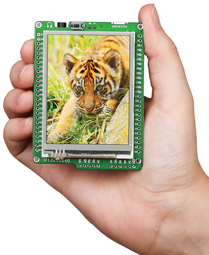
The 32-bit microcontrollers belonging to the PIC32MX family, manufactured by Microchip are the most developed circuits available in this manufacturer’s offer (presently, the offer comprises of 69 different types). Depending on the version, they provide their users with the Flash memory from 16 up to 512KB and from 8 to 128KB of RAM memory. Their maximum clock frequency is 80MHz, which means performing 80 million operations per second (MIPS). They are available in 28 to 100 pin enclosures, making accessible up to 85 I/O lines. Depending on the version, they offer a wide range of peripherals kit. The biggest difference, in comparison to ARM architecture-based microcontrollers available in the market, is the fact that PIC32 is made with the use of a different architecture, i.e. MIPS. It causes that designing engineers while making a decision which unit to use, have a choice. In many applications, PIC32 microcontrollers performance exceeds ARM performance. The fact that needs to be emphasized is hardware unification maintained both within the very PIC32 family, as well as among 8 and 16-bit Microchip controllers.
When we add to this universal, free MPLAB X programming environment that supports all circuits of this manufacturer, designing engineer obtains easiness of migration to more and more developed units.
In order to help a future user acquaint with the properties of a given microcontroller’s family, their manufacturers offer demonstrative and development kits. They should be made in such a manner as to give designers a tool whose universality will allow quick and effective command of at least basic designing principles with the use of possibilities

offered by a given circuit. Of course, Microchip is not an exception here, since it makes considerable number of such kits, whereas, the subject of this article is an overview of development kits for MikroElektronika PIC32 kits. This Serbian company has been present in the market for over 10 years. It is an official designing partner of Microchip (and additionally of several other, renown manufacturers).
MikroE development kits are characterized with considerable universality and incredibly well thought workmanship. The simplest one is “MINI-32” (MIKROE-763). It has been designed with the use of PIC32MX534F064H microcontroller (64KB Flash, 16KB RAM, USB OTG, CAN). On the PCB board dimensionally corresponding to the DIP40 (51×18mm) enclosure, apart from the processor, there are two quartz generators (for MCU clocking and RTCC circuit), the set of 3 LED’s, RESET button and USB port. thanks to the embedded USB HID bootloader, the kit can be connected directly to a PC. The board can also be supplied by means of the USB port or from the external source 3,3VDC. Of course, we have access to 40 lines of a microcontroller entered in the form of pads. The kit constitutes some kind of a PIM (Plug-In-Module) module allowing to extend user’s application with a PIC32MX family microcontroller.
The other one is the “mikromedia kit for PIC32” (MIKROE-597) designed by means of the most extended PIC32MX460F512L microcontroller. On a single PCB board (with the dimensions of 81 × 60mm), we obtain a compact, multimedia development kit with a considerable number of peripherals. So, let’s start enlisting – well, we will find there, among others, a colourful LCD display (320 × 240) with resistive touch screen, stereo mp3 codec, 3-axial acceleration sensor, USB Slave connector (connection to a PC / kit power supply, audio

connector, MMC/SD memory card slot, additional retentive Flash memory 8Mbit to store the data and easy access to 52 microcontroller’s pins as lead pads. The board is directly connected by means of the USB port to a PC (thanks to the embedded, pre-programmable HID bootloader), but, there is still a possibility to program the PIC32 microcontroller by means of the external programmer (mikroProg or ICD2/3). Additionally, kit’s functionality, can be extended by means of using a considerable number of expansion boards offered by MikroElektronika (among others, Battery Boost shield, Proto shield or mikroBus shield).
With all offered benefits, the PIC32MX460 microcontroller is not equipped with the Ethernet interface. Presently, a slogan “Internet of Things” moves from the concept phase to the execution phase that is why, the possibility of connecting application/hardware to the global network is becoming a desired feature. Embedded Ethernet interface can be found in the PIC32MX795F512L microcontroller. The MikroElektronika’s kit designed with its help, is multimedia for PIC32MX7 (MIKROE-596). This is also a compact, multimedia PCB board (dimensions: 125 × 89mm). Apart from the previously described peripherals (TFT display and others:-)) it offers additional integrated temperature sensor, additional EEPROM memory, a joystick, RS-232 connector, USB Host/Slave connectors and obviously, Ethernet slot.
Thanks to the lead pads, we have access to the total of 60 pins of the microcontroller.
The best universal design (and biggest dimensions 266 × 220mm :-)) are offered by the “EasyPic Fusion v7” (MIKROE-1205) kit that has been nominated in the “Best Tool” category during the Embedded World 2013 trade fair in Nuremberg. Listing all its features would certainly exceed the volume of this article, it is just worth mentioning that thanks to the universal PIM pad, it supports 65 different Microchip microcontrollers from the PIC24, dsPIC33 (both 16-bit) and PIC32 families.

The functionality of the kit can be extended by means of “Click” – type boards attached by means of the MikroBus connection (on the base board, there two connections of this type).
The manufacturer, at the moment, offers over 50 different “clicks”.
In many other Mikro Elektronika kits, apart from the boards, the customer receives a DVD with examples and documentation, user’s manual in a beautifully prepared and printed book, printed connections diagram and USB cable to connect with PC.
MikroElektronika also manufactures programmers and C language compilers, Pascal and Basic to a wide range of microcontrollers (including PIC32). To find out more details of the offer, please visit TME’s site (www.tme.eu), which is the official distributor in Poland.
Pawel Sioda
www.tme.eu


